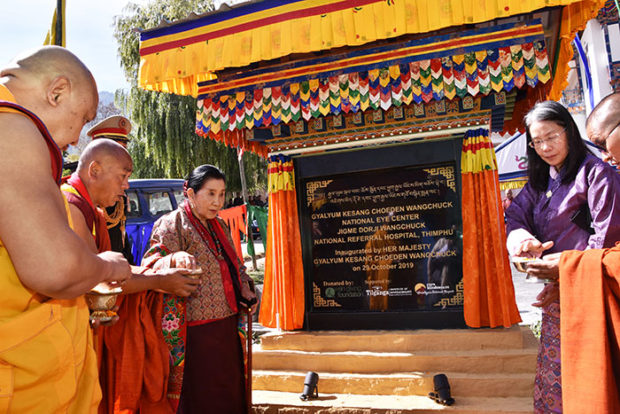THIMPHU — Her Majesty the Royal Grand Mother Kesang Choeden Wangchuck inaugurated the Gyalyum Kesang Choeden Wangchuck National Eye Centre in Thimphu Wednesday.
Members of the Royal Family, Cabinet and council members, chief justice, and other dignitaries attended the inauguration ceremony.
The eye center, named in honor of Her Majesty the Royal Grand Mother, is technically and financially supported by the Himalayan Cataract Project (HCP) in Nepal and Wen Giving Foundation , an organisation based in Malaysia.
The hospital, built at US$ 1.6 million, is funded by Wen Giving Foundation, which is founded by Mr and Mrs Wen. The funding came through the HCP.
Health Minister Dechen Wangmo said the HCP and Wen Giving Foundation were involved in charitable programs for eye globally and in the region. “The HCP has been our partner for many years and they have been working with our eye programme. This is a project that came through them with the blessing of Her Majesty the Gyalyum.”
Since the inception of the eye program in 1987, Minister said the prime objective of the program had been to prevent, control, and cure major causes of avoidable blindness, and to make essential eye care services available to all, as envisioned in the ‘Vision 2020: Right to Sight’.
“In achieving this overarching goal, Your Majesty’s patronage and gracious support has been instrumental in spearheading the development of this state-of-the-art eye hospital, which we are confident will provide the much needed eye services in the country,” the health minister said.
The centre is expected to provide more specialised eye care services and develop sub-specialisation in Ophthalmology in the country. Besides the OPD (out-patient department) services, the centre will also provide inpatient services for ophthalmology cases, and surgical services within the facility.
“This will also be a place where we will build the capacity and competency of our health workers,” Minister Dechen Wangmo added.
The centre will house 16 beds in four Aseptic wards, specialised OPD and in-patient eye services, three operation theatres, and other amenities necessary to provide people-centred eye services.
Today, eye care services are well integrated at all levels of the health facilities in the country.
Further, she said targeted outreach programmes through mobile camps helped take eye services to the majority of the Bhutanese people.
The health ministry is also collaborating with Essilor to eradicate poor vision in the country.
Despite these great strides in providing primary eye care, the burden of eye diseases requiring specialised care is increasing.
“Therefore, it has become imperative that we also provide specialised services to back up our primary eye care services. To this end, the establishment of the Gyalyum Kesang Choeden Wangchuck National Eye Centre as the first standalone hospital for eye is, indeed, very timely and auspicious,” the health minister said.
There are plans to bring expertise from the region, especially through the HCP to perform surgery. “After they go back, our health worker will manage the cases. We are already in discussion with our partners to work out this modality.”
On human resources, Minister said it was a big concern for the health ministry. “We are limited in terms of human resources.”
However, for the hospital, the ministry is working with the partners to build the capacity and competency of local health workers.
The health minister said the ministry was in discussion with the Royal Civil Service Commission (RCSC) to re-open the certificate course for Ophthalmic Technician at the faculty of nursing and public health. “This is a much-needed course in the country.”
Royal Institute of Health Sciences, now the faculty of nursing and public health, stopped providing the course a few years ago.
“We are working closely with the RCSC to reopen this course so that our people can be trained to become opticians and ophthalmic technicians so that they can provide these services in the country,” Minister said.
The new eye centre requires about 22 ophthalmic technicians.
The 19 health workers, including the ophthalmologist and ophthalmic technicians at the ophthalmology department with the national referral hospital in Thimphu, saw 39,635 OPD cases last year.
Today, the country has a total of 54 ophthalmic technicians, nine ophthalmologists and optometrist each.
“I assure our unwavering commitment to make the Gyalyum Kesang Choeden Wangchuck National Eye Centre a seat of excellence that will provide the best eye care services to our Bhutanese people,” Minister Dechen Wangmo said.


